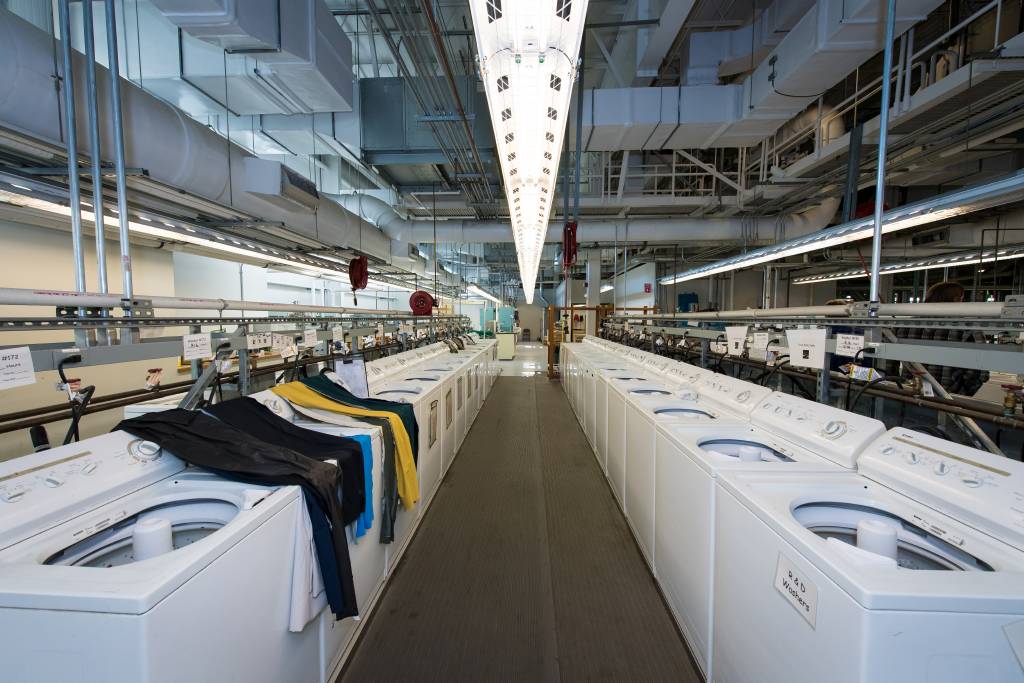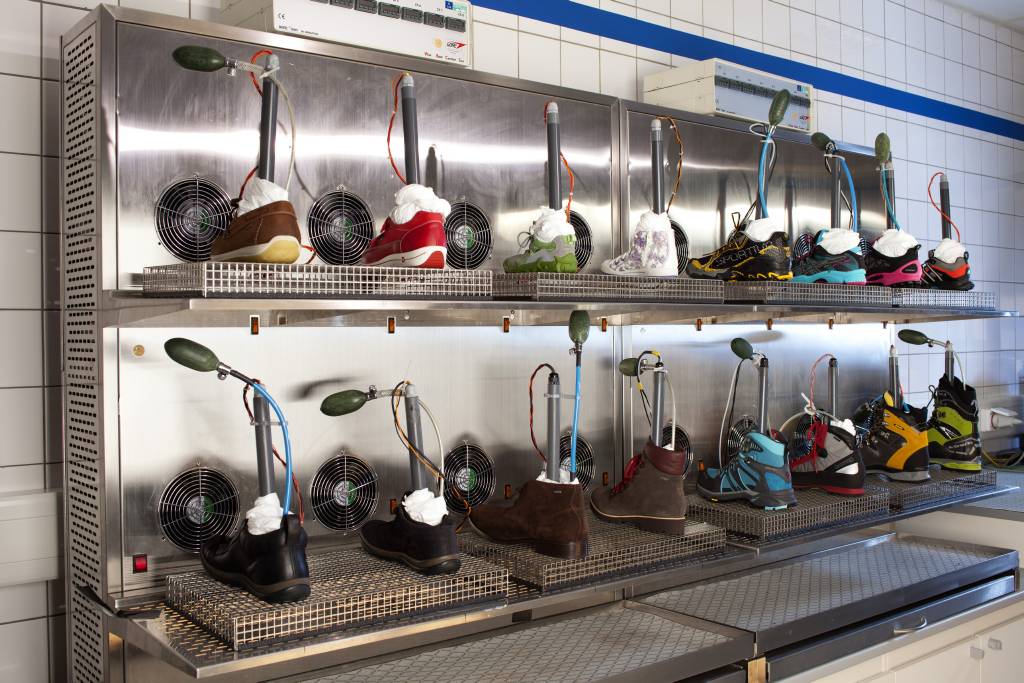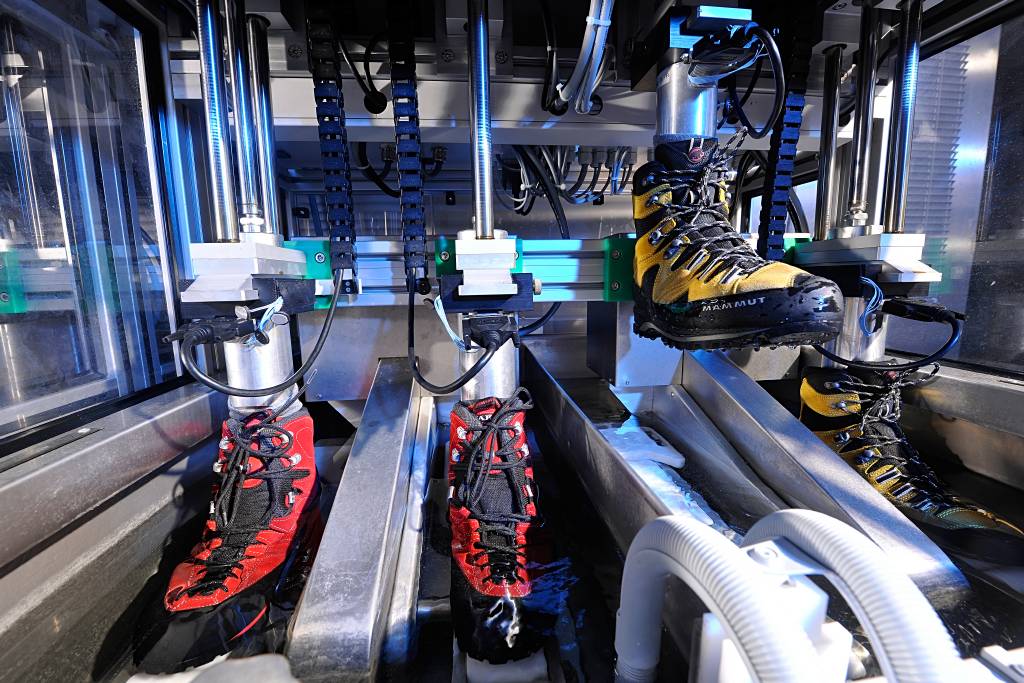If you’ve been outside in the rain, you’re probably familiar with GORE®, best known for its waterproof, breathable and windproof GORE-TEX® fabrics. Many consider GORE the gold standard—not least for their Guaranteed to Keep You Dry® promise. You might not know it, but to keep that claim, they test each and every piece of gear other companies create with their fabrics before it gets put in stores. We took a look at exactly how that testing gets done.
In GORE’s multimillion dollar laboratories across the globe, experts can perform more than 400 different tests to ensure the efficacy of each product. “We can test fabrics, textiles and garments in our state-of-the-art facility in a condensed and controlled form that mimics what [is seen] out in the field,” said Brandon Bell, expert in textile testing for GORE.
Testing begins with textiles. GORE-TEX fabrics need to meet three requirements to “pass.” They must be breathable, waterproof and durable.
Breathability
Let’s say you’re heading into New Hampshire’s White Mountains for a freezing winter hike. With temperatures in the 20s, you need outerwear that keeps you warm and dry, inside and out. Sweating is part of the fun, and you need gear that breathes as you’re hoofing it uphill. That’s where GORE’s breathability test come in.
One of GORE’s most utilized breathability tests is called the Sweating Hot Plate. This machine features a metal plate with pores in it. Scientists heat up the plate and place a fabric over the top, measuring how much sweat-like solution goes through the material, with the rate of breathability customized depending on the activity (walking gear requires less breathability than running gear).
Twenty years ago, in addition to the widely used Sweating Hot Plate test, GORE developed their own additional test: a water bath that’s the same temperature as a human body covered by the fabric to be tested. Potassium acetate or sodium chloride, both which absorb water, are used to draw moisture up through the material—then it’s a matter of comparing the pre- and post-test weights to see how much water was picked up. The more water picked up, the more breathable the material.
Waterproofing
What about your trip to Big Bog, Maui, Hawaii, one of the wettest places in the world? In the high-altitude bog, you’ll likely experience torrential downpour, but you’re hoping to remain dry underneath your raingear. Obviously, testing of the gear you’ll wear is important—and you don’t want to be the guinea pig.
While most GORE-TEX membranes, found attached to the underside of the fabric, are waterproof, if the durable water repellent (DWR) doesn’t let rain bead up and roll off, you’ll probably feel wet. That’s because wet fabric changes the garment’s draping properties, causing the water-drenched gear to lie right against your skin, chilling you. The industry standard for DWR testing is a spray test. That’s just a nozzle that sprays the fabric for half an hour. If the material continues to repel water during that time, it passes. GORE has its own internal test, too—one that’s too top secret to divulge—but, according to GORE, it does a better job of predicting the actual effect of rain outside.

Spray Test. (Image Courtesy: GORE)
Durability
Hiking the Pacific Northwest Trail is not for the faint of heart. The daily mileage can be long and the lack of trail makes bushwacking simply part of the trek. It’s on trails like these that the GORE durability test steps in.
Each GORE fabric is made of two to three layers glued together. That adhesive bond has to be strong enough to stand up to time and wear. That’s why GORE has a room with more than 50 washing machines (it’s extremely loud), all in a row. But these aren’t your home machines—these agitate the fabric for up to 48 hours straight. If the material stands up to that, it’ll stand up to years of outdoor use.

Washing machines.(Image Courtesy: GORE)
Pro tip? If you want to reinvigorate the DWR on your GORE-TEX garments, wash and tumble dry them. When drying your jacket, after the jacket is initially dry (via hang dry or dryer) you must add an additional 20 minutes of drying on medium temperature in order to properly restore the DWR performance. The (low) heat, according to Christy Haywood, GORE applications engineer, will actually bring back the beading ability of your used gear.
Once the fabrics are approved, the entire garment is put through the paces. In their testing facilities in Shenzhen, China, GORE has a rain room where they can drench gear with anywhere from two to 22 inches of rain per hour—the upper end being for impossibly bad conditions like 13.8 inches/hour, which is the U.S. rain record set 70 years ago in West Virginia.
Planning a road-trip through the Colorado in the summer, where afternoon thunderstorms are plenty frequent? No problem. GORE just might put your garment through its on-road motorcycle test, where a mannequin gets doused with six gallons of water per minute. While the rain rooms are high-tech, the testing methods are low-tech. Instead of sensors, lab technicians inspect each piece of gear after the “rain” lets up—looking and feeling for water inside each of the products.
However, when a garment leaks, it’s not a bad sign. “Having a garment that leaks the first time it’s tested means that the designers are trying something new and interesting,” said Michele Leckington, design and application expert at GORE. “The most interesting and innovative brands are the ones that are most likely to have leakage.” When products fail the tests, GORE simply goes back to the brand and partners with them to create a solution.
Footwear
Footwear is a whole different matter. There are three major tests: the Footwear Breathability Test (FBT), Centrifuge Test and Wet Flex Test.
Imagine this: Five miles into your sweltering summer hike into the Grand Canyon, your feet start to sweat. This leads to some of the biggest blisters you’ve ever experienced, and plenty of pain. But that might not have happened if you were wearing GORE gear. That’s because the FBT features a sweating foot mannequin that goes inside every shoe, replicating both the temperature of the human body and its sweating process. GORE measures the moisture leaving the shoe by weight, ensuring a minimum amount of sweat can escape before letting the footwear go into production.

Footwear Breathability Test. (Image Courtesy: GORE)
Some parts of the Appalachian Trail are more riverbed than hiking trail, depending on the time of year. For thru-hikers and day hikers alike, dry feet are imperative. That’s why GORE’s next test is the very aggressive Centrifuge Test—filling a shoe with water, spinning it at 250 revolutions per minute and testing for escaping water. The thought is, if the water can get out, it can also get in. And that’s no good for a GORE shoe or boot.
Hiking the Camino de Santiago takes tenacity and stick-to-itiveness. Oh, and footwear that can stand up to 500 miles of day in, day out use. That’s where the Wet Flex Test comes in, where a rack of foot mannequins with sensors are fitted with shoes or boots and submerged in water. The footwear is exposed to the flex of the “foot” and water for over 48 hours or up to 200,000 flexes, and only passes if the sensors don’t detect water. That’s intense.

Wet Flex Test. (Image Courtesy: GORE)
Of course, these products get outside of the lab, too. GORE does hours of field tests for many products. National Outdoor Leadership School instructors, construction workers, ski patrollers and even GORE associates take new styles out into the real world to see how they do after 100, 200 or even 500 hours of wear. Because sometimes, old-fashioned testing is what’s called for.
All of this adds up to products you can trust, whether you’re encountering light snow in Aspen or torrential downpour in the Florida Keys.
